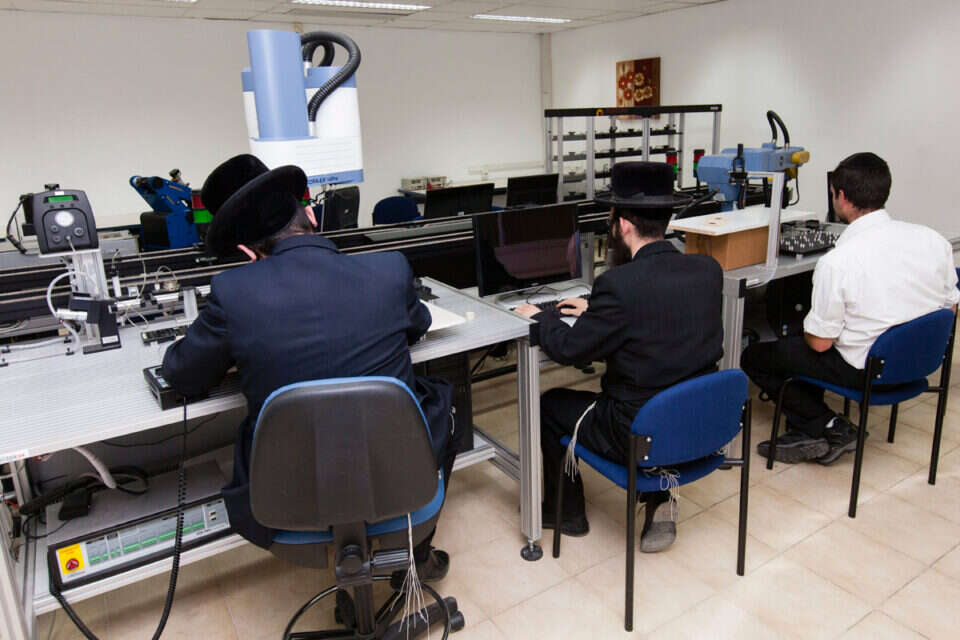The schism and rift between secular and ultra-Orthodox Jews is breaking records. One of the reasons for this lies in the lack of integration of Haredim into the labor market. Most of the secular public thinks that the Haredim are not interested in working, while many of the Haredim claim, correctly, that they would like to, but that they cannot integrate, due to a lack of essential skills and due to scholastic and cultural gaps.
While the state pours hundreds of millions of shekels into training ultra-Orthodox workers, and opens dozens of tracks and training programs, integration rates are low to nonexistent, and the few who manage to get hired do not survive.
According to a report by the Aharon Institute, in cooperation with the Haredi Institute for Policy Research, among Haredim who underwent 12 months of professional training in high-tech, less than 15% on average came to work in the industry. Despite the huge investment, the share of Haredi men in high-tech remains around 1%. The chances of an ultra-Orthodox man integrating into high-tech without a matriculation certificate and without a degree are minimal: about 2.5%.
A central way to bridge the gaps lies in employers' willingness to invest in Haredi workers, train them and teach them personally, based on personalization, and according to the knowledge levels of each employee. Especially in soft skills, such as interpersonal communication, working with clients, standing in front of an audience, and handling crises and objections.
Imagine an ultra-Orthodox man who graduated with honors from the Lev Institute and succeeded in integrating into a high-tech company. He has excellent programming skills, but has never experienced teamwork, brainstorming, interpersonal communication with customers and managers, overcoming challenges and difficulties, receiving feedback, and understanding the political nuances of organizational culture. Knowledge of the profession is not even half the way to success for an ultra-Orthodox man who has never experienced a modern work environment.
Employers' investment in ultra-Orthodox workers and adapting the work environment to them cannot amount to a "modest dress code" or keeping kosher. These cannot bridge the tensions between worldviews and the moral and cultural gaps.
For example, in Haredi society, unquestioned acceptance of authority by parents, community, or rabbis is one of the most important values, while an employee in a modern society is required to think critically, assertively, challenge existing concepts, stand up for principles, and raise objections.
Modesty and humility are also supreme values among the ultra-Orthodox, while the work environment requires the employee to "sell himself" through interaction with customers, strengthening self-confidence and building personal branding. The kitchenette conversations in many organizations, most of whose population is secular, will often deal with realizing the concept of a material "good life" – vacations, real estate, expensive hobbies – while in Haredi society, the choice of modesty and a low standard of living is ideological, with an emphasis on immateriality, in accordance with the concept of "Pat with salt you will eat and water sparingly you will drink."
According to a report by the Aharon Institute, in cooperation with the Haredi Institute for Policy Research, among Haredim who underwent 12 months of professional training in high-tech, less than 15% on average came to work in the industry. Despite the huge investment, the share of Haredi men in high-tech remains around 1%. The chances of an ultra-Orthodox man integrating into high-tech without matriculation or a degree are minimal: about 2.5%
In order to overcome the moral and cultural gaps, employers must provide Haredi workers with personal support and guidance that will be adapted to the difficulties and challenges they face. While it's a lot of investment, it will pay itself back eventually. This is particularly true in light of the current solutions available from artificial intelligence technologies, which are able to "tailor" a personal training process for each employee according to the knowledge and skills that he must improve, shorten, streamline and significantly reduce the cost of the training processes, and personally adapt them to the needs and abilities of each employee, and do all this according to the pace of learning, professional level, skills and needs of him and the organization.
Many claim that the solution to integrating Haredim into employment lies in strengthening core studies, but this is only the starting point that allows them a first foothold. In order for them to succeed in persevering in the workplace over time, great efforts are required on the part of employers to assist the acclimatization processes of Haredi workers personally, with all their personal, moral and cultural characteristics.
Wrong? We'll fix it! If you find a mistake in the article, please share with us

